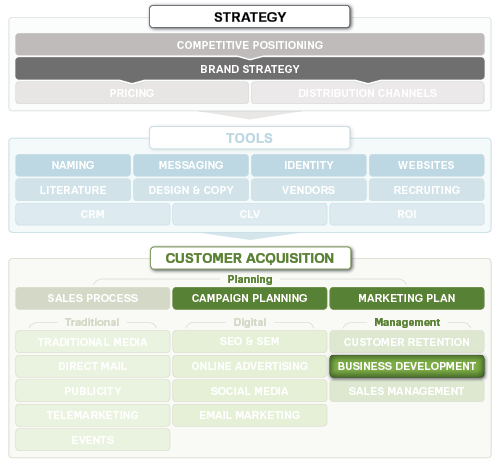Marketing Guides
Creative & Brand Development
Business Development
Business development in the marketing process refers to high-level partnerships that generate revenue, create better products and/or increase efficiency. These partnerships can help you
- Access new markets
- Increase sales to existing markets
- Improve your access to technology
- Boost your productivity
- Gain capital (human or financial)
In a true partnership, companies collaborate to achieve a common goal. It’s more than a short-term promotion such as a special offer or marketing to each other’s customers. Instead, it’s an agreement to do business together while sharing responsibilities, resources, risks and rewards.
For example, here are three examples of true partnerships:
| TO CREATE NEW PRODUCTS | TO INCREASE EFFICIENCY | TO CREATE NEW PRODUCTS |
|---|---|---|
| A computer manufacturer enters a partnership with a fashion designer to create a limited-edition laptop and matching case.
They create a team of employees from both companies to designs and market the product. The computer manufacturer produces the computers, the designer creates the bag, and they share revenue fairly based on their cost structure. |
A software company has a fantastic new product but is inundated with customer service calls they can’t handle. They approach a telemarketing firm that specializes in the software industry.
Instead of just hiring the telemarketing firm, they create a partnership. The telemarketing firm provides service for a greatly reduced fee, then receives a substantial commission for selling the software company’s other related software. The partners work closely together to maximize their revenue on the sales program. |
A design firm partners with a direct mail fulfillment firm to offer each other’s services to their respective clients.
Each company promotes the partnership to new prospects & existing customers. They offer the service with a single point of contact–if a design client needs mail services, the design firm manages the implementation rather than just referring the client to the mail firm. Each company bills the other at special rates so there’s room for a fair markup, providing each company with additional revenue. |
In these examples, each company has distinct responsibilities in the partnership. They each devote resources (either time or money) to the program, and if it fails, they have similar levels of risk. They’ve also fairly divided the rewards.
The first step in a successful partnership is structure; the right arrangement aligns both companies toward an important common goal. The second step is execution; a partnership should be managed like any business with careful attention to detail, solid communication and focus on the end goals.
With the right structure and management, your business development deals have the greatest potential for success.
| Best Case | Neutral Case | Worst Case |
|---|---|---|
| The partnership is balanced and productive for both parties.
You share responsibilities, resources, risks and rewards, and the partnership delivers substantial revenue, cost savings or new opportunities for both companies. |
Your partnership isn’t balanced — perhaps you have more responsibilities and resources allocated or you don’t share fairly in the rewards.
It produces value, though not what you had expected; you hope the situation will improve with time. |
You enter into a partnership and invest substantial resources, but the partnership goes awry.
Your “partner” isn’t delivering as needed and you don’t have much recourse – your partner isn’t really providing resources or sharing risk. As a result, you end the partnership and lose valuable time and money on the deal. |
Not Sure Where to Start with Business Development?
Access detailed step-by-step plans in our new marketing website.
It’s free to use
Sign up for Marketing MO account (free) for step-by-step guidance with your business development project. Need more 1-on-1 help? Connect with our strategists to tell us about your needs.
Since business development partnerships involve multiple departments in each company, there are usually a number of people involved in the deal. It’s often an executive or high-level “biz dev” person leading the process for each company, although in small companies a sales or marketing executive will take the reigns. However, creating a partnership is more complex than pure sales — it requires a solid understanding of the business and operational objectives of multiple organizations.

Business Development Key Concepts & Steps
Before you begin
You can think about business development at any time. It’s common to identify potential partnerships during annual planning time, so many companies start pursuing deals after finishing a new marketing plan.
Identify potential partnerships
Brainstorm to identify partnerships that can help you meet your goals. For example, there may be related companies with customer relationships in a different market; you may have vendors or suppliers who can help you improve your products or firms that can help you round out your services.
Think about structure as well – the resources each party would provide, how the partnership would be managed and what each party would invest and earn.
Identify the right “biz dev” person to lead the project
A good “biz dev” person has a broad understanding of business strategy and operations; s/he can also can negotiate and close a complex sale. It’s a different skill set than many sales reps offer, but you may have a rep or executive on your team who can do these kinds of deals — or you may tackle it yourself.
Pitch a partnership
Develop a strong pitch to capture the attention of your potential partners; focus on the high-level benefits for each party. As you move through the sales process, cover all aspects of the partnership including detailed structure and terms.
Share responsibilities, resources, risks and rewards
You have a much stronger chance of success when a partnership is balanced. As you negotiate the deal, make sure your interests are completely aligned and that each party is contributing in all areas.
After Creating a Business Development Partnership
When you set up a partnership, make sure your company manages and executes so that you’ll reap the full benefits. As part of the partnership you may launch new marketing campaigns – treat them as you would any other marketing program.
BUSINESS DEVELOPMENT PLANNING TEMPLATES / MARKETING PLANS / PROJECT MANAGEMENT
EVERYTHING YOU NEED FOR YOUR BUSINESS DEVELOPMENT PROJECT
